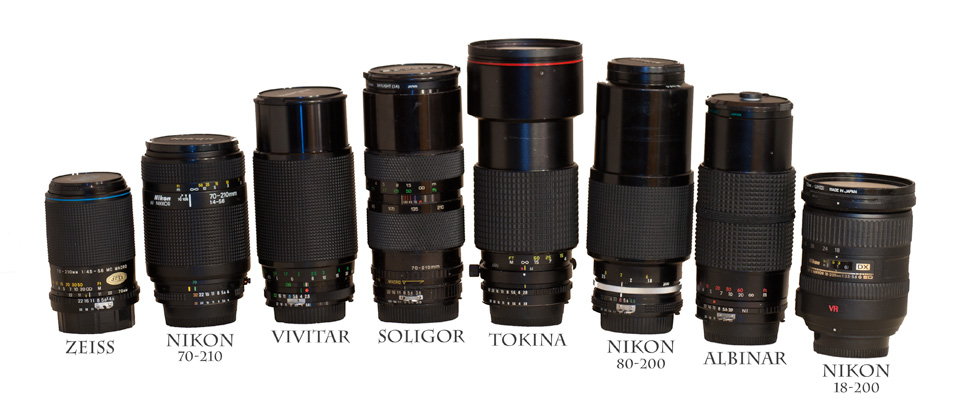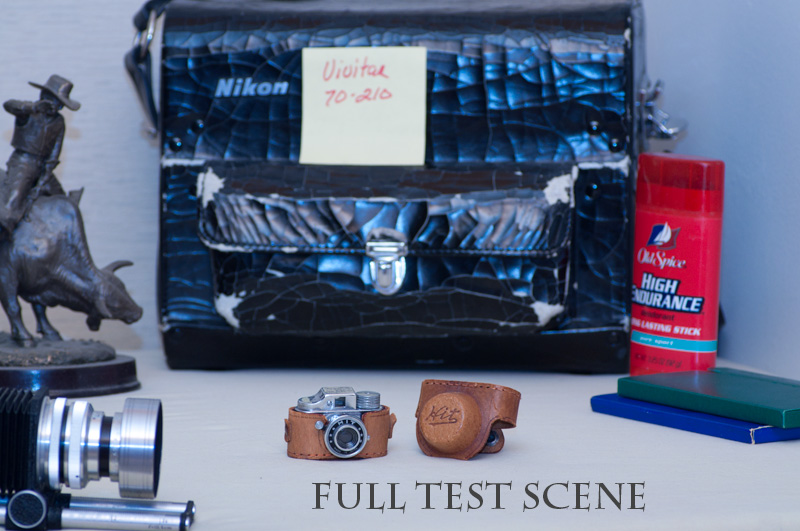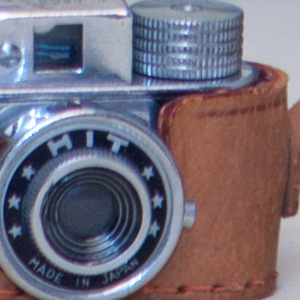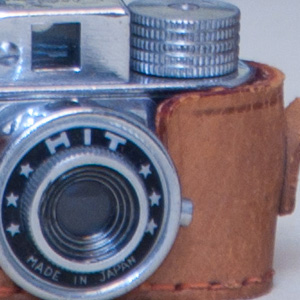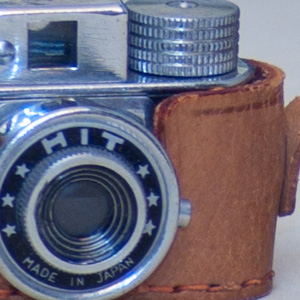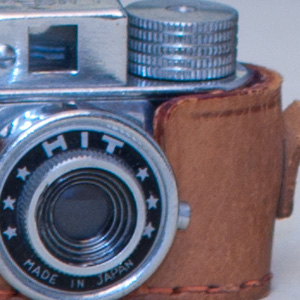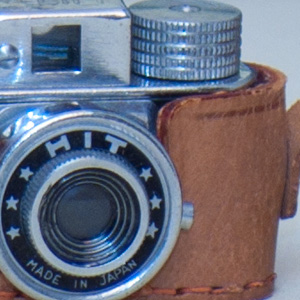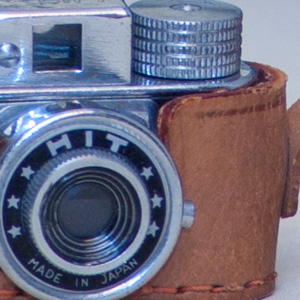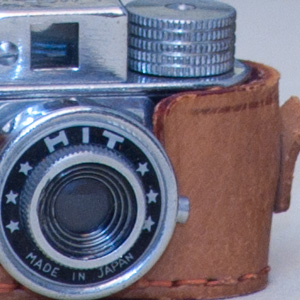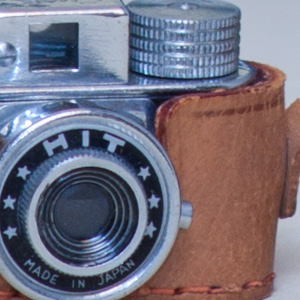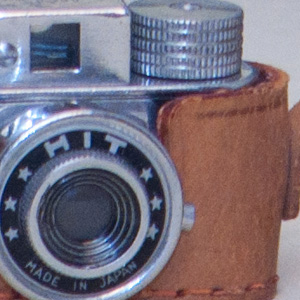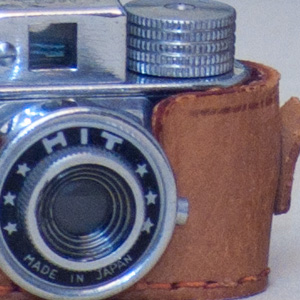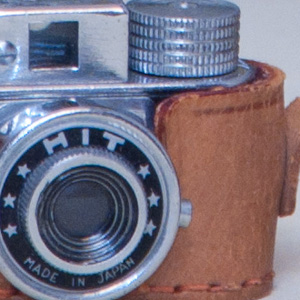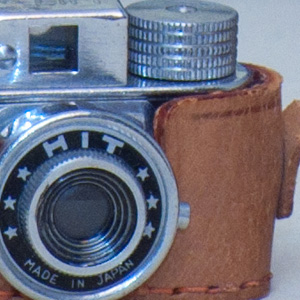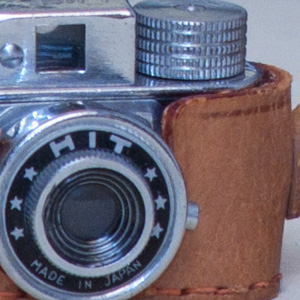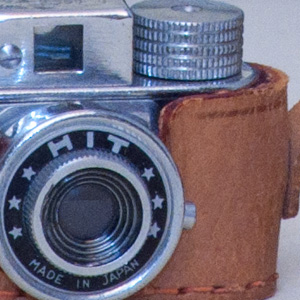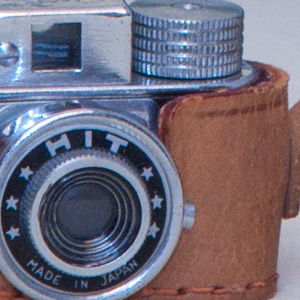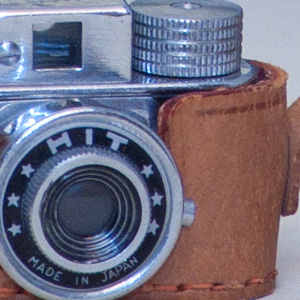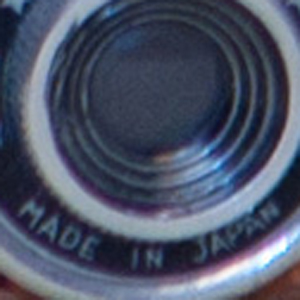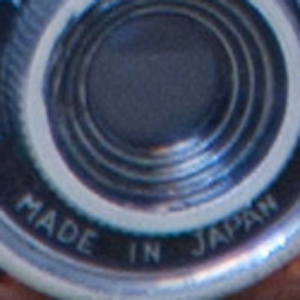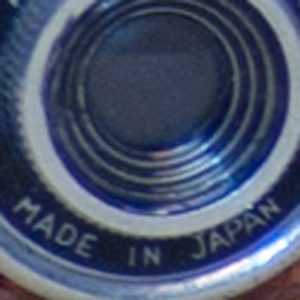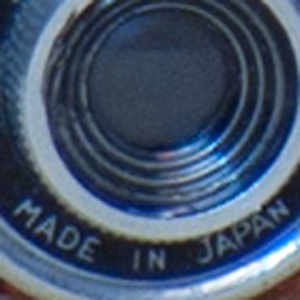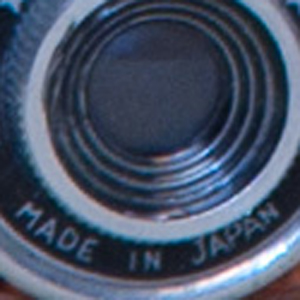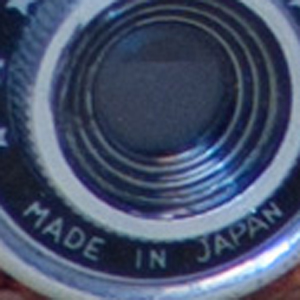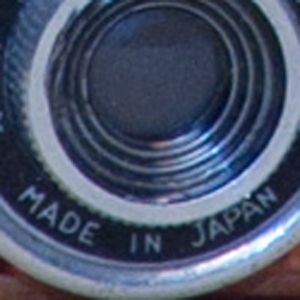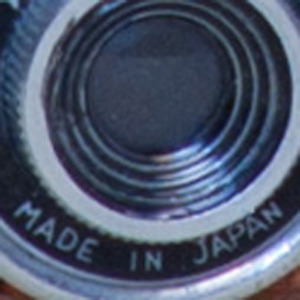|
There are 2
crops
from each lens, one at f/5.6 and another at f/8 shot on a Nikon D90 camera. No sharpening, although I did adjust
tone slightly. This test is more for sharpness, than anything else...
I'm always looking for the sharpest lenses. I plan on other tests
with these same lenses and a couple more.
My favorite lens (because
of it's versatility) is the Nikon 18-200, but I'm a little disappointed with
it's results on this test at f/5.6. At f/8 it's very good.
An interesting thing
that I have never noticed is that when sorted by size, almost all
the f/5.6 shots had smaller file sizes than those shot at f/8. This
makes sense noticing that almost all those shot at f/8 had better
color saturation and of course, more detail.
My personal
favorite from this test is Nikon's 70-210
f/4-5.6,
it super sharp and performs much better than most lenses I've used
for color fringing or chromatic aberrations. The Tokina 80-200 &
Nikon 80-200 close seconds. Zeiss, and not surprisingly, the Vivitar and Soligor performed
very good.
AND THE ALBINAR, which I re-shot 3
times since I thought it couldn't be that bad, but yep, it is. It's
only chance for survival is if it does ANY better "hooded" and
"polarized" at f/11 or f/16, although I doubt it. So far it looks like it would be good for soft focus
effects by using an old trick of applying Vaseline to the lens'
filter, however in this case I would apply it directly to the front
element, or you might hit the front element with a hammer for producing
other special effects. In all actuality I'll probably scavenge the Nikon
mount for another lens and give the elements to kids for magnifying
glasses or include it in an eBay auction as a bonus.
Conclusions
If I need speed
or limited depth of field I will carry the HEAVY Tokina f/2.8 and use the
Nikon 70-210 for my general purpose lens. I will however, most of
the time, have the Nikon 18-200 attached to my camera body since I
can capture just about anything I want, in a hurry. If I have time I
will definitely change lenses unless the 18-200 performs better in
other tests. BTW, I had the 18-200's VR turned off
while tripod mounted, which is recommended.

Choosing the right lens
When choosing a lens there are a few considerations;
size & weight, price, use and quality.
also see this
Size
If you hike to your subject you'll want a small lightweight lens. If
you shoot studio only this will not matter. The Zeiss is perfect for
this... very small, lightweight and very sharp.
Price
The price of these lenses range from $.99 (yes 99 cents) to about
$1000's used. If price doesn't matter forget these lenses and get a constant
aperture f/2.8 such as the Nikon 80-200 f/2.8, priced at $1,224.95
or the Nikon 70-200 f/2.8 priced at $2,399.95. For the rest of us
there are choices that are close, albeit no match. All but the Nikkor's and Tokina lenses from this test are dirt cheap on eBay. The Soligor is
a great lens, it is heavy, built like a tank and very sharp. Forget
the Albinar!!! The Tokina is the fastest at f/2.8, heaviest and
largest lens of this group... very nice. Vivitar makes great lenses
called "Series 1" which are hard to beat at the prices you
can buy them for used. Don't confuse them with the regular Vivitar
lenses and run away from the new ones that have VIVITAR in big
letters on the focusing/zoom ring. These newer Vivitar Series 1
lenses are cheap copies of the original Series 1 lenses.
Use
When considering your purchase think about how you plan on using it.
If you need a lens for architectural work, you want a lens that can
at least tilt, but if this your main use I highly recommend getting
a view camera instead. You can buy a complete system for the price
of a 35mm camera and a few lenses. Your images will be much sharper
than you'll get out of any 35mm system and you'll be able to control
your composition much better. The downfalls are the size & weight,
usage requirements like tripod (a must) and the speed in which you
can capture images.
My personal experiences have taught me that
I can get better images out of a good lens and a good teleconveter than I can from a cheap lens with twice the focal
length. Teleconveters allow you to increase the focal length of your
lens but you'll want to get a top quality converter. Pay the price
here for the very best you can afford since you'll use a good one
often on several different lenses. Expect to pay $400-$500 for a top
quality converter. I suggest getting the one that matches your main
grouping of long lenses. I am heavily into Nikon equipment so I want
Nikon converter. If you don't have the budget I have found the Vivitar 2x Teleconveter a "decent" alternative. I have never used a
3x teleconveter that I liked and probably never will.
If portraiture or low
light is your main use then you'll
want the fastest lens you can afford to limit the DOF and reduce the
need for flash. On a 35mm system I suggest 120mm to 400mm for head
shots, 80mm to 200mm for upper body shots and 60mm to 150mm for full
body shots.
If close-up or "Macro/Micro" usage is the
main goal you'll want a lens capable of capturing the intended
image. For images up to about 1 to 1 (life-size) many lenses can get
you there but may require an "extension tube". I love these lenses
because they are usually the sharpest lenses and can focus much
closer than a non-Macro/Micro lens. I also suggest manually focusing
when doing Macro/Micro work and turning off your lenses vibration-reduction/stabilization (VR on Nikon) if applicable. I personally use a tiltable
lens or a Bellows for most macro work if I have time due to the DOF
altering capabilities. I prefer longer macro lenses because they
allow me to be further away from my subject, which, when doing macro
work, can be very close. If you have the time use a bellows for
Macro/Micro and you'll have much greater control than you will have
otherwise. NOTE: if you are purchasing a bellows I HIGHLY recommend
getting one that has at least tilting capabilities. A bellows with
tilting & shift (T/S) capabilities lets you use any lens as a
"Perspective Control" optic so you don't have to spend so much for
brand name T/S lenses. (Nikon's T/S lenses are about $2000 each and
are only a single focal length, although they are truly awesome.)
If you have no special needs choose a lens
for cost. Get the best you can afford. If you buy the very best
lenses you'll usually be able to
sell it in the future for what you pay for it now and maybe more. Unless
you have a very special need for them I'd stay away from mid range
zooms and get one of the lenses that can cover most situations like
an 18mm-200mm zoom. You'll loose a bit of quality using zooms but
the convenience is sometimes worth it.
If the lens needs to be VERY durable and
has a high chance of destruction, get whatever your willing to loose
if that happens. I'd get the Soligor in an instant for this. If you
are going to take the ultimate care of your lens, get the best you
can for your budget.
Quality
"You get what you pay for"... usually. (Brand name lenses
are usually more expensive, although not always the best buy for
your money.) The best lenses are "constant
aperture" lenses, which only applies to zoom lenses. ("Constant
aperture" means that as you change focal lengths the F-STOP stays
constantly at the set F-STOP.) The fixed focal length lenses are call
"prime" lenses. The faster the lens the better for 2 reasons; low
light use and "Depth of Field" (DOF) control. 1. The faster the lens,
the less light required to expose the image. 2. Fast lenses have a
shallower DOF so you can better control the background and foreground's
degree of focus.
Lenses come in a variety of materials,
usually metal or plastic. Many new lenses are mostly plastic, while
most older lenses are all metal. If size & weight are a concern
you'll have to decide for yourself what is best, but for me it's
metal if I can get it.
The quality of the glass in a lens is also
a cost factor, that's one reason you can see so much difference in
price for similar lenses.
Time and time again great lens makers like
Canon, Leica, Nikon and Zeiss prove themselves with the highest
quality lenses, which can cost over a million dollars EACH, so
always get the best you can afford, unless it's for your child to
play with, then get the Albinar. Top quality lenses go up in price,
especially after they are discontinued, while mediocre lenses become
paperweights. I have top quality lenses from the 1960's and earlier
that I still use today and don't plan on ever selling, although they
will sell for more than I paid for them new.
Sidenote
I am
very disappointed that Nikon is making most new lenses in the "G"
style. The "G" is NOT GOOD for my preferred style of shooting
pictures. What "G" means is that you can no longer set an aperture
manually since they took the ring completely off the lens. You can
only use these lenses with newer cameras as they are just about
useless on older, especially manual focus cameras. And in many, a
large share of the material used in construction is plastic. boo-hoo
:(
I never thought Nikon would let us
life-long users down, and although they haven't completely, they're
getting close. Many of the lenses I'd like to have are only in the
"G" style and I won't buy a "G" lens unless it's a must have, such
as the 18-200, which I HIGHLY recommend. Call Nikon and tell them "please don't take my apertures
away"... (Almost sounds like an old Simon & Garfunkel song) ...
and no more PLASTIC!!!
|
1-800-Nikon-US
1-800-645-6687 |
Kert Kley |
![]()
